Education
- Postdoctoral Fellow, Michigan University, 2014-2016
- Ph.D. Northwestern University, 2014
- M.S. Northwestern University, 2011
- B.S. Purdue University, 2009
Background
Dr. Aaron Young is an Assistant Professor in the Woodruff School of Mechanical Engineering at Georgia Tech and a member of the Institute for Robotics & Intelligent Machines. He also is a program faculty member of the Biomedical Engineering School. He is director of the Intelligent Prosthetic & Exoskeleton Controls (EPIC) Lab focused on lower limb robotic augmentation. His research focuses on optimizing control systems in wearable robotic devices by studying their effect on human locomotion biomechanics in clinical populations. The long term goal is to create clinically viable control systems for wearable robotic lower limb assistive devices that are smart and intuitive to use. His previous experience includes a post-doctoral fellowship at the University of Michigan in the Human Neuromechanics Lab working with lower limb exoskeletons and powered orthoses to augment human performance. His dissertation work at Northwestern University in the Center for Bionic Medicine at the Rehabilitation Institute of Chicago focused on using machine learning strategies for enabling intent recognition systems for powered lower limb prostheses.
Research
- Lower Limb Prostheses and Exoskeletons, Human Augmentation, Wearable Robotics, Assistive Devices, Lower limb gait biomechanics, Machine learning, Physical human-robot control systems, Biological Signal Processing, Intent Recognition, Myoelectric Control, Human Subject Experimentation, Robotic Mobility Enhancement

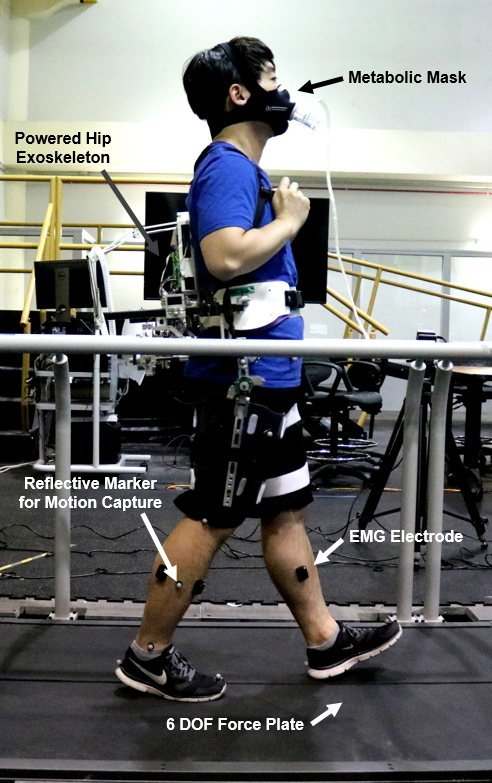
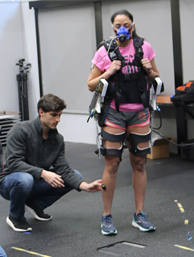
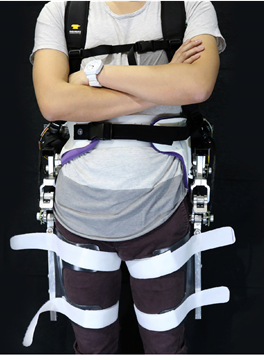
Examples of experiments using the EPIC lab’s hip exoskeleton devices. These include community ambulation of ramps and stairs, biomechanical testing, and using EMG information to inform advanced control systems using machine learning.
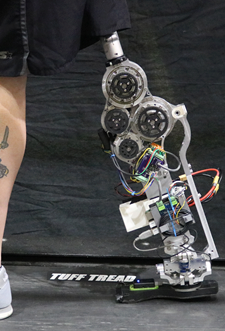
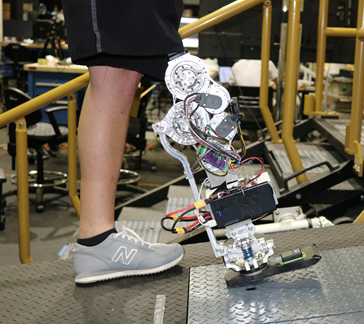
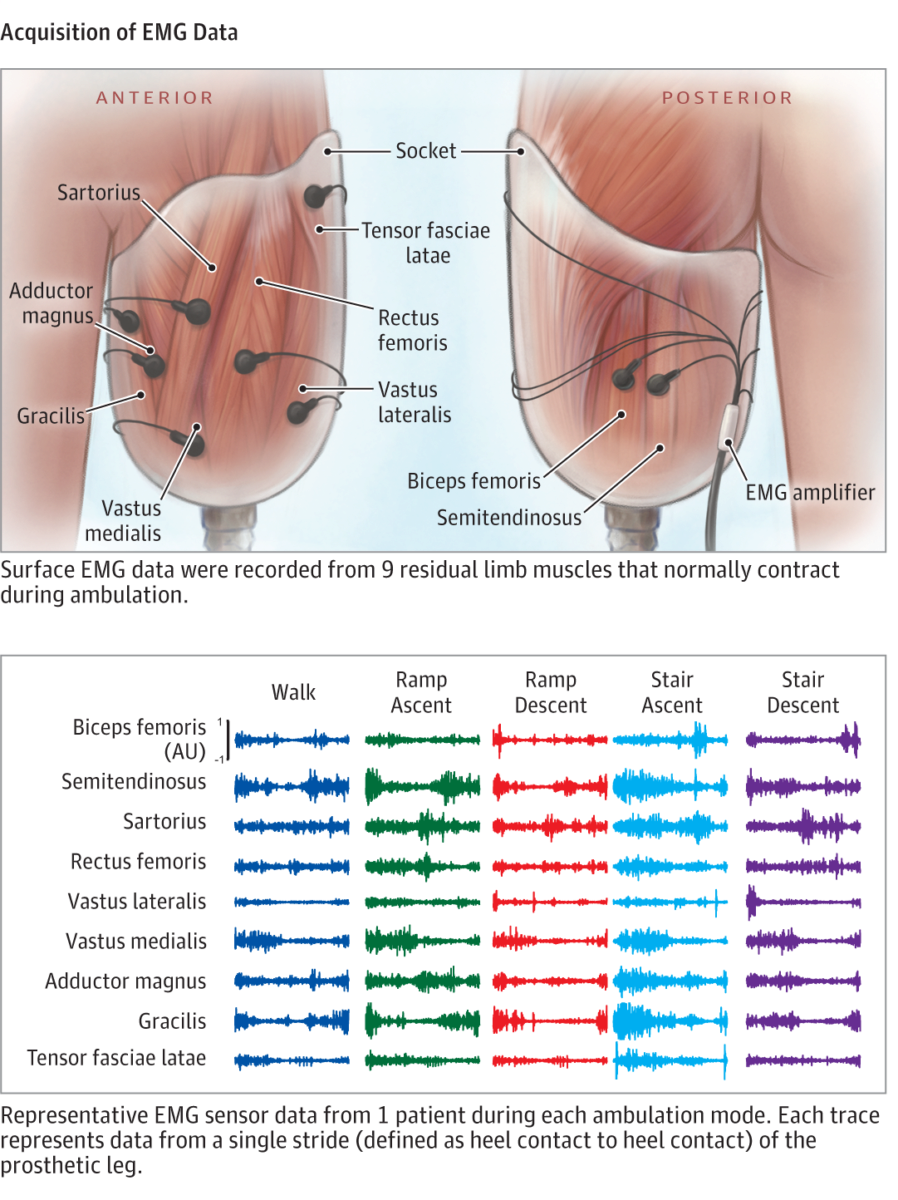
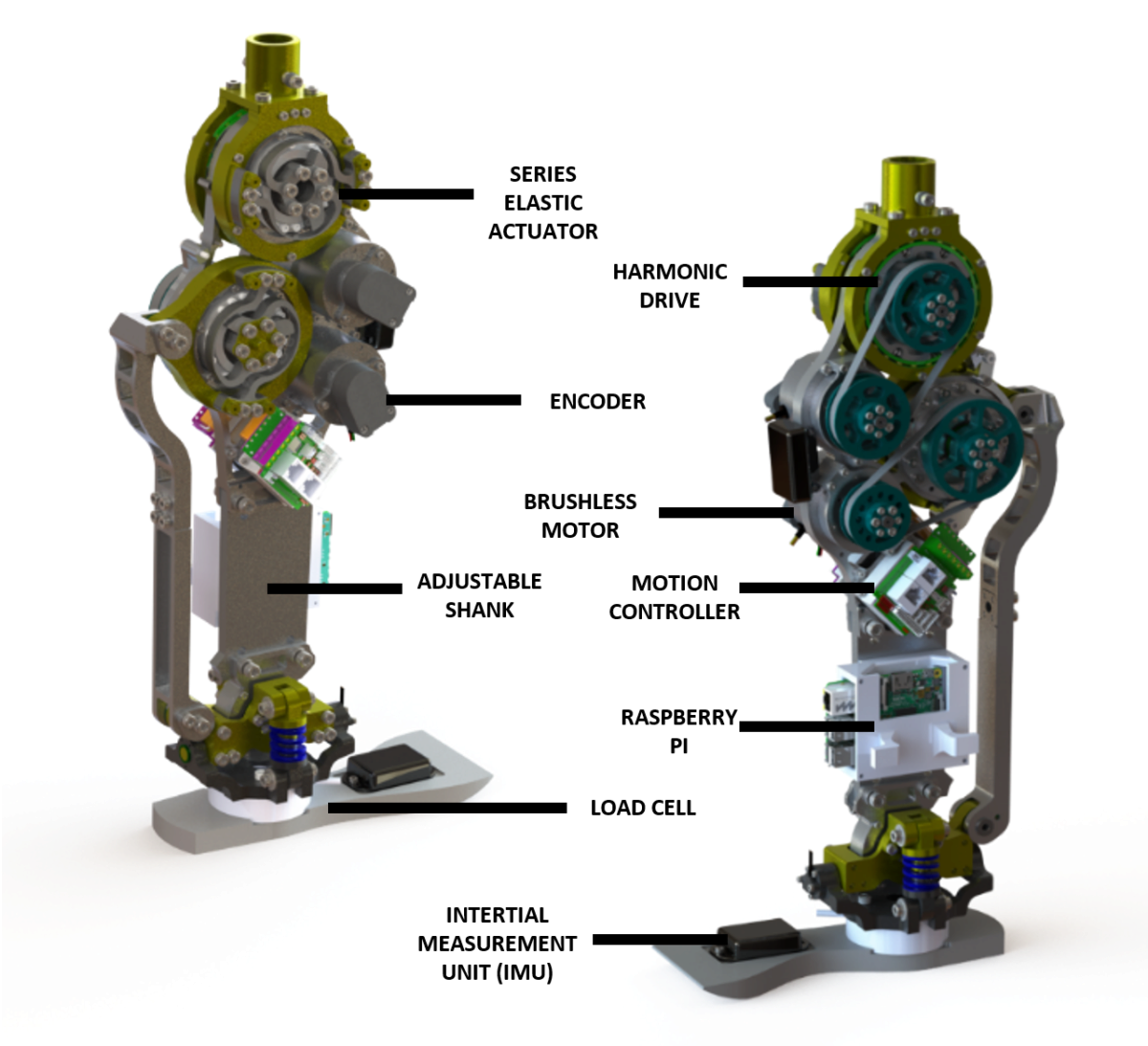
Powered knee/ankle prosthesis examples. Key innovations of our research include designing intelligent intent recognition systems, optimizing control based on amputee biomechanics, and clinical testing of our robotic solutions a wide range of individuals with transfemoral amputation in comparison to non-robotic (passive) prostheses.
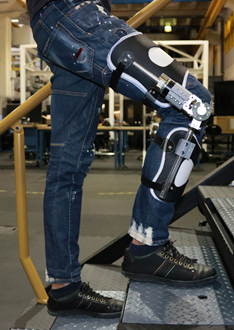


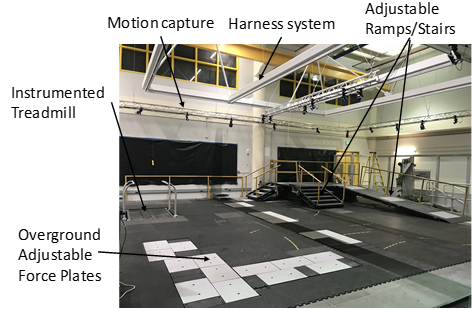

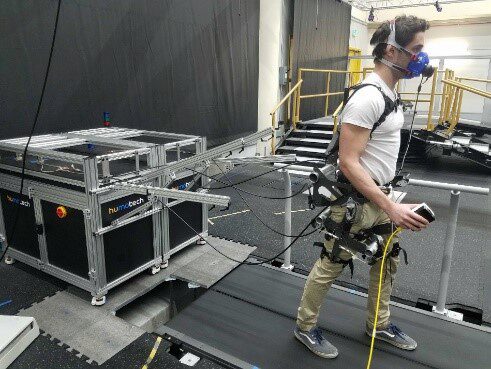
EPIC lab facility. We have a state-of-the-art testing facility for wearable robotic devices. This includes a unique terrain park for measuring inverse dynamics of humans using exoskeletons and prosthesis with force plate instrumentation for multiple stair sets, an adjustable incline ramp, and overground locomotion in both straight and turning configurations. Full surround motion capture supports kinematic reconstructions of movement. The HumoTech system (right) allows for emulation of prostheses and exoskeletons for controller testing.
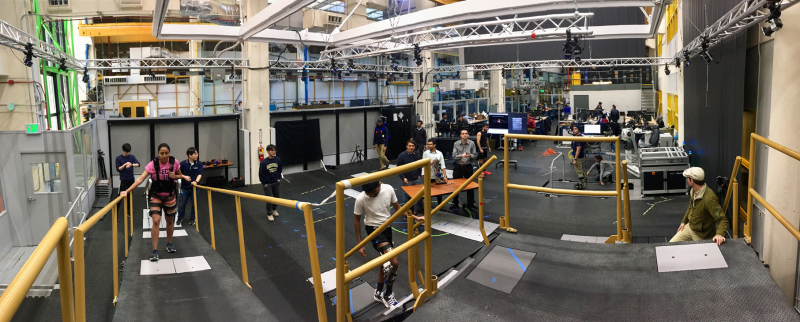
Distinctions and Awards
- New Faces of Engineering award through DiscoverE – IEEE USA winner, 2017
- Military Health System Research Symposium Team Award, 2015
- BME Research Award in Neural and Rehabilitation Engineering, 2014
- 3rd place award in Student Paper Competition at IEEE EMBC 2013 Conference, 2013
- Open Finalist in 2013 EMBS Student Paper Competition, 2013
- Sarah Baskin Award for Excellence in Research – 1st place, 2012
- Northwestern Applied Research Day – Best Poster and 3rd place presentation, 2012
- National Science Foundation Graduate Research Fellowship (NSF-GRFP), 2010
- National Defense Science and Engineering Fellowship (NDSEG), 2010
- Royal E. Cabell Fellowship, 2009
- Ana Groff, Stella Thai, Inseung Kang, Jeff Hsu, Aaron Young, “Control Strategies of a Powered Assist Hip Exoskeleton in Subjects with Stroke,” 45th Meeting of the American Academy of Orthotists & Prosthetists, Orlando, FL, 2019.
- Krishan Bhakta, Jonathan Camargo Leyva, Maximillian Spencer, Brian White, Noah Cho, Kinsey Herrin, Lee Childers, Aaron Young, “Effect of Experimental Powered Prosthesis on Hip Kinetics: A single Case Pilot Study,” 45th Meeting of the American Academy of Orthotists & Prosthetists, Orlando, FL, 2019.
- Claire Kilpatrick, Summer Lee, Inseung Kang, Hsiang Hsu, Lee Childers, Aaron Young, “The Impact of Hip Exoskeleton User Interface on User Comfort and Metabolic Cost: A Pilot Study,” 45th Meeting of the American Academy of Orthotists & Prosthetists, Orlando, FL, 2019.
- Pratik Kunapuli, Krishan Bhakta, Aaron Young, “'Neural Network Based Estimation of Gait Phase in a Powered Hip Exoskeleton,” Biomedical Engineering Society Conference, Atlanta, GA, 2018.
- 29. Will Flanagan, Jonathan Camargo Leyva, Aaron Young, “The Value of EMG for Estimating Continuous Locomotion Parameters During Human Ambulation,” Biomedical Engineering Society Conference,Atlanta, GA, 2018.
- 28. Eun Chan Kwak, Dawit Lee, Inseung Kang, Aaron Young, “The Effect of Powered Assistance on Uphill Human Walking Using a Robotic Knee Exoskeleton,” Biomedical Engineering Society Conference, Atlanta, GA, 2018.
- 27. Hsiang Hsu, Inseung Kang, Aaron Young, “Design and Evaluation of a Proportional Myoelectric Controller for Hip Exoskeleton during Normal Walking,” ASME Dynamic Systems and Controls Conference, Atlanta, GA, 2018.
- 26. Jonathan Camargo-Leyva, Krishan Bhakta, Aaron Young, “Stochastic Optimization of Impedance Parameters for a Powered Prosthesis Using a 3D Simulation Environment,” ASME Dynamic Systems and Controls Conference, Atlanta, GA, 2018.
- 25. Inseung Kang, Hsiang Hsu, Aaron Young, “Design and Validation of a Torque Controllable Hip Exoskeleton for Walking Assistance,” ASME Dynamic Systems and Controls Conference, Atlanta, GA, 2018.
- 24. Krishan Bhakta, Jonathan Camargo-Leyva, Aaron Young, “Control and Experimental Validation of a Powered Knee and Ankle Prosthetic Device,” ASME Dynamic Systems and Controls Conference, Atlanta, GA, 2018.
- 23. Jonathan Camargo-Leyva, Aaron Young, “Muscle synergies in simultaneous movement of upper limb,” International Conference of the IEEE Engineering in Medicine and Biology, Honolulu, HI, 2018.
- Jonathan Camargo-Leyva, Noel Csomay-Shanklin, Bharat Kanwar, Aaron Young, “Continuous Walking Speed Estimation using Neural Networks and Multi-Sensor Data Fusion,” International Conference of the IEEE Engineering in Medicine and Biology, Honolulu, HI, 2018.
- Aaron Young, Krishan Bhakta, Jonathan Camargo-Leyva, Lee Childers, “Powered knee/ankle prostheses for improving walking capabilities in individuals with transfemoral amputation,” Military Health System Research Symposium, Kissimmee, FL, 2018.
- 20. Krishan Bhakta, Jonathan Camargo-Leyva, Aaron Young, “Sensor Fusion for Continuous Walking Speed Estimation on Powered Prostheses,” Dynamic Walking, Pensacola, FL, 2018.
- 19. Inseung Kang, Hsiang Hsu, Aaron Young, “Effect of Hip Torque Assistance Levels on Human Metabolic Cost,” Dynamic Walking, Pensacola, FL, 2018.
- 18. Claire Kilpatrick, Summer Lee, Inseung Kang, Jeff Hsu, Lee Childers, Aaron Young, “Investigating the Impact of Hip Exoskeleton User Interface on User Comfort and Metabolic Cost,” 44th Meeting of the American Academy of Orthotists & Prosthetists. New Orleans, LA, 2018. (**Best Poster Award**)
- 17. Jonathan Camargo Leyva, Aaron Young, “Combined Strategy of Machine Vision with a Robotic Assistant for Nail Biting Prevention.” 14th International Conference on Computer and Robot Vision, Edmonton, CA, 2017.
- Aaron Young, Jessica Foss, Hannah Gannon, Daniel Ferris, “Changes in Human Metabolics Based on Assistance Timing with a Powered Hip Exoskeleton.” 40th Annual Meeting of the American Society for Biomechanics, Raleigh, NC, 2016.
- Annie Simon, Kimberly Ingraham, John Spanias, Aaron Young, Levi Hargrove, “Development and Preliminary Testing of a Flexible Control System for Powered Knee-Ankle Prostheses.” 6th IEEE RAS/EMBS International Conference on Biomedical Robotics and Biomechatronics, Singapore, 2016.
- Aaron Young, Bridget Cook, Daniel Ferris, "Proportional Myoelectric Control of a Robotic Hip Exoskeleton." 39th Annual Meeting of the American Society for Biomechanics, Columbus, OH, 2015.
- Nicholas Fey, Aaron Young, Ann Simon, Suzanne Finucane, Kimberly Ingraham, Elizabeth Halsne, Todd Kuiken, Levi Hargrove, “Towards Clinically Viable Neural Control of Powered Lower-Limb Prostheses.” Military Health System Research Symposium. Fort Lauderdale, FL, 2014.
- Suzanne Finucane, Annie Simon, Kim Ingraham, Nicholas Fey, Robert Lipschutz, Aaron Young, Elizabeth Halsne, Levi Hargrove, “Training for Transfemoral Amputees Ambulating on a Powered Lower Limb Prosthesis.” 40th Meeting of the American Academy of Orthotists & Prosthetists. Chicago, IL, 2014.
- Aaron Young, Ann Simon, Nicholas Fey, Levi Hargrove. “Classifying the Intent of Novel Users During Human Locomotion Using Powered Lower Limb Prostheses.” 6th International IEEE EMBS Conference on Neural Engineering. San Diego, CA, 2013.
- Ann Simon, Nicholas Fey, Kimberly Ingraham, Aaron Young, Levi Hargrove. “Powered Prosthesis Control During Walking, Sitting, Standing and Non-Weight Bearing Activities Using Neural and Mechanical Inputs.” 6th International IEEE EMS Conference on Neural Engineering. San Diego, CA, 2013.
- Aaron Young, Ann Simon, Levi Hargrove, “An Intent Recognition Strategy for Transfemoral Amputee Ambulation Across Different Locomotion Modes.” International Conference of the IEEE Engineering in Medicine and Biology, Osaka, Japan, 2013. (** 3rd place, student paper competition finalist **)
- Dennis Tkach, Aaron Young, Lauren Smith, Levi Hargrove, “Performance of pattern recognition myoelectric control using a generic electrode grid with Targeted Muscle Reinnervation patients,” International Conference of the IEEE Engineering in Medicine and Biology, San Diego, CA, 2012.
- Aaron Young, Lauren Smith, Elliott Rouse, Levi Hargrove “A New Hierarchical Approach for Simultaneous Control of Multi-Joint Powered Prostheses.” IEEE RAS-EMBS International Conference on Biomedical Robotics and Biomechatronics, Rome, Italy, 2012.
- Aaron Young, Levi Hargrove, “Effects of Interelectrode Distance on the Robustness of Myoelectric Pattern Recognition Systems,” International Conference of the IEEE Engineering in Medicine and Biology, Boston, MA, 2011.
- Nicholas Fey, Ann Simon, Aaron Young, Levi Hargrove, “Knee Swing-initiation and ankle plantar flexion control using an activate prosthesis across walking speeds and users.” 37th Annual Meeting of the American Society of Biomechanics, Omaha, NE, 2013.
- Aaron Young, Levi Hargrove, “Assessment of Electrode Configuration on the Robustness of Myoelectric Pattern Recognition to Electrode Shift,” Myoelectric Controls Symposium, Fredericton, CA, 2011.
- Elliott Rouse, Aaron Young, Camila Shirota, Connor Griffith, Levi Hargrove, “Data Fusion for Lower Limb Prosthesis Locomotion Mode Detection.” Biomedical Engineering Society Conference, Austin, TX, 2010.
- Aaron Young, Levi Hargrove, “The Effects of Electrode Misalignment on Myoelectric Pattern Recognition,” Biomedical Engineering Society Conference, Austin, TX, 2010.
- Aaron Young, Levi Hargrove, “Strategies to Reduce Myoelectric Pattern Recognition Sensitivity to Electrode Shift,” International Society of Electrophysiology and Kinesiology Conference Proceedings, Aalborg, Denmark, 2010.
Patents
- Levi Hargrove and Aaron Young, “Systems and Methods for Hierarchical Pattern Recognition for Simultaneous Control of Multiple Degree of Freedom Movements for Prosthetics.” U.S. Patent No. 9,907,489, March 6, 2018.
- Aaron Young and Levi Hargrove, “Ambulation Prediction Controller for Lower Limb Assistive Device.” U.S. Patent Number 9,443,203 B2, September 13, 2016.

